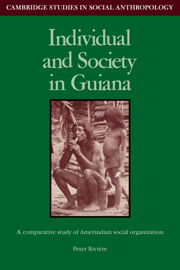Book contents
- Frontmatter
- Contents
- Acknowledgments
- 1 Peoples and approaches
- 2 The settlement pattern: size, duration, and distribution
- 3 Village composition
- 4 The categories of social classification
- 5 Aspects of social relationships
- 6 Autonomy and dependency
- 7 The individual in society
- 8 Guiana society and the wider context
- Notes
- Bibliography
- Index
- CAMBRIDGE STUDIES IN SOCIAL ANTHROPOLOGY
2 - The settlement pattern: size, duration, and distribution
Published online by Cambridge University Press: 01 October 2009
- Frontmatter
- Contents
- Acknowledgments
- 1 Peoples and approaches
- 2 The settlement pattern: size, duration, and distribution
- 3 Village composition
- 4 The categories of social classification
- 5 Aspects of social relationships
- 6 Autonomy and dependency
- 7 The individual in society
- 8 Guiana society and the wider context
- Notes
- Bibliography
- Index
- CAMBRIDGE STUDIES IN SOCIAL ANTHROPOLOGY
Summary
In Chapter 1 the point was made that it is a mistake to characterize the indigenous societies of the Guianas in terms of what they lack. Even so, it is true to say that the absence of any formal social groupings that could act as pegs on which to hang a description makes the problem of presentation that much more difficult. The closest one can get to identifying a social group that has any sort of corporate existence is the inhabitants of a single settlement. Even this is not entirely satisfactory, for these groups have only a transitory presence. Settlements are short-lived, and even within their lifetime their populations, and thus the composition of the group, undergo continual change as people come and go. But, ephemeral as settlements are, to focus on them is an approach that allows an initial glimpse of fleeting stability in a fluid and relative world. It is in the formation, composition, and dispersion of settlements, apparently so chaotic, that it is possible to observe the range of choices that the social structure makes available to the individual, and beyond them to the very principles by which the social structure itself is articulated. Thus a suitable place to start this study is with settlement size, duration, and distribution.
First, however, it is necessary to indicate that the term “settlement” cannot be used to refer to the same thing throughout the region. There are those people (Waiwai, Ye'cuana, Piaroa, and Panare) whose settlements usually consist of a single communal dwellinghouse. There are those (Trio, Waiyana) who live in nucleated villages composed of a number of houses. There is the pattern uniquely exemplified by the Akawaio, who have nucleated central villages with dispersed houses located at distant garden sites.
- Type
- Chapter
- Information
- Individual and Society in GuianaA Comparative Study of Amerindian Social Organisation, pp. 15 - 29Publisher: Cambridge University PressPrint publication year: 1984



